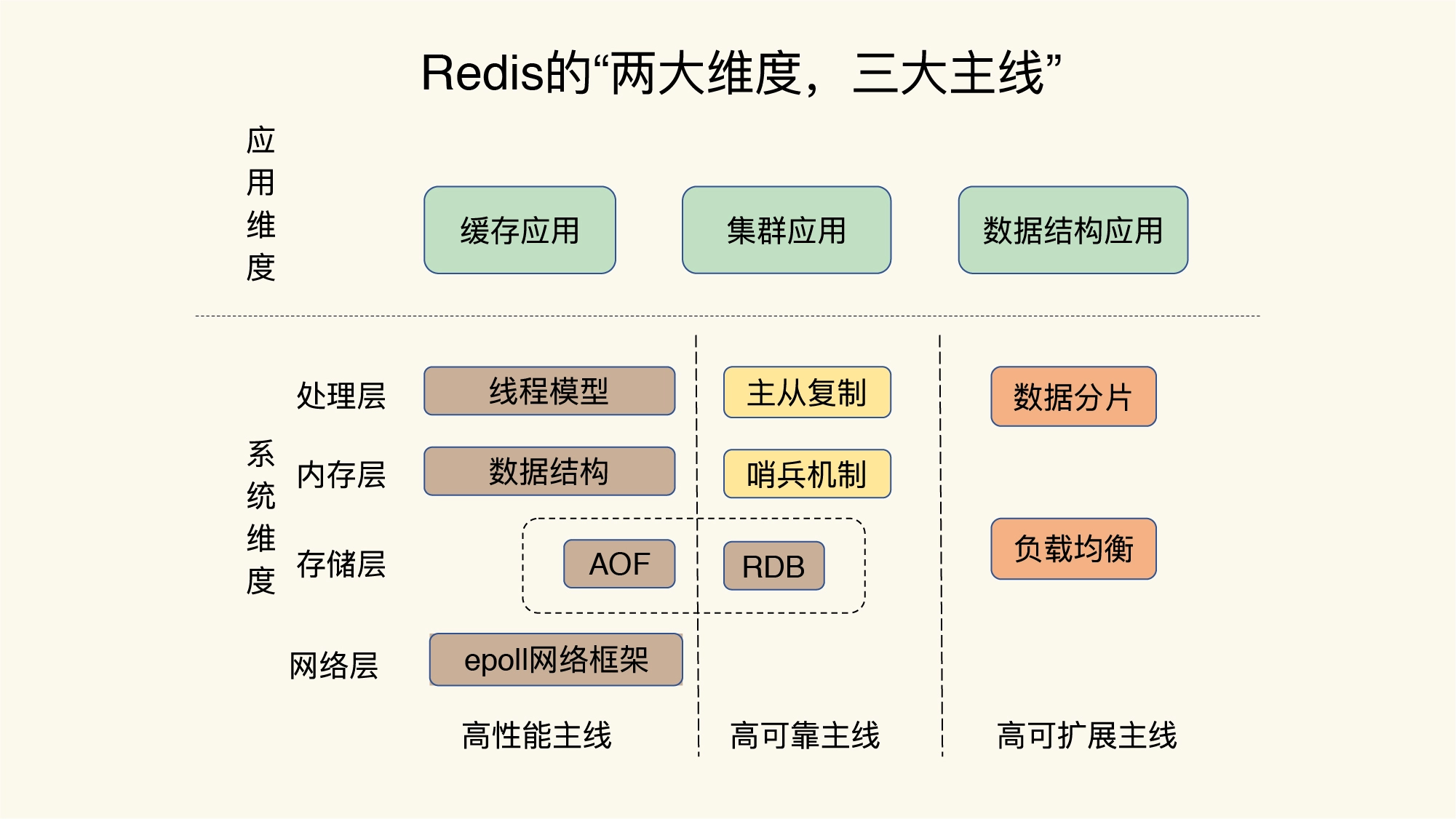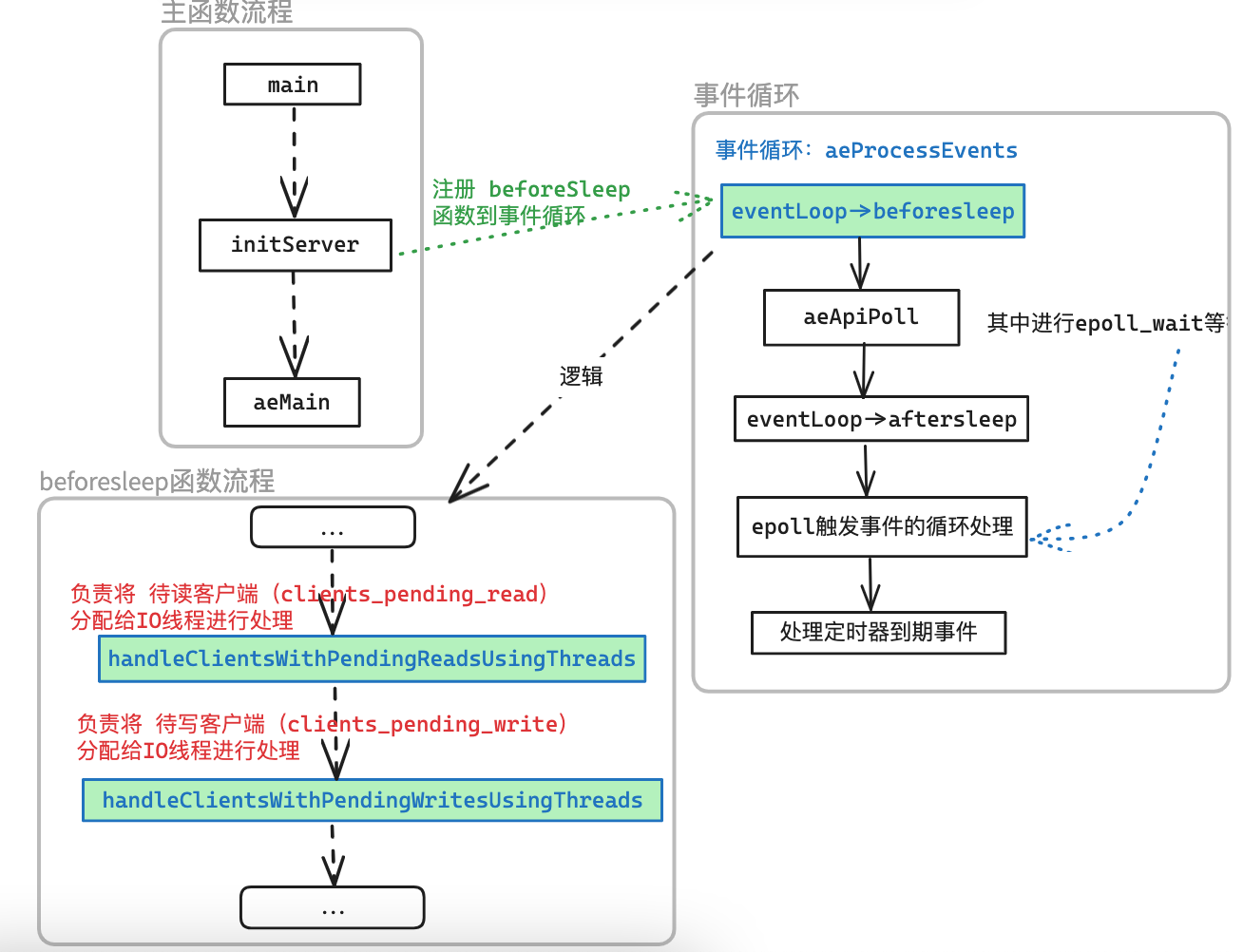Redis学习实践(二) -- 多线程、RDB和AOF
Redis支持的关键特性和机制:多线程、RDB、AOF。
本篇梳理Redis支持的关键特性和机制:多线程、RDB、AOF。
1. 背景
继续梳理Redis支持的关键特性和相关机制,多线程、RDB、AOF。
除了上篇提到的数据类型和结构,Redis的其他知识点可以以下面的全景图串起来:
说明:本博客作为个人学习实践笔记,可供参考但非系统教程,可能存在错误或遗漏,欢迎指正。若需系统学习,建议参考原链接。
2. 事件循环和多线程
主线程基于epoll进行IO多路复用判断处理,前面 梳理Redis中的epoll机制 中已经梳理过,此处不做展开。
线程初始化调用栈:main -> initServer -> InitServerLast
1
2
3
4
5
6
7
8
9
10
// redis/src/server.c
void InitServerLast() {
// 创建Background后台线程,目前有3个线程:文件延迟关闭、AOF fsync延迟落盘、对象延迟释放
bioInit();
// 多线程特性,io_threads_num不为1时启用,对应配置文件中的:io-threads。可在config.c中找配置对应关系
initThreadedIO();
// 使用jemalloc时有效,设置 jemalloc 后台线程,配置文件中 jemalloc-bg-thread 默认打开
set_jemalloc_bg_thread(server.jemalloc_bg_thread);
server.initial_memory_usage = zmalloc_used_memory();
}
initThreadedIO 初始化IO线程流程:
1
2
3
4
5
6
7
8
9
10
11
12
13
14
15
16
17
18
19
20
21
22
23
24
25
26
27
28
29
30
31
32
33
34
35
36
37
38
39
40
41
42
43
// redis/src/networking.c
#define IO_THREADS_MAX_NUM 128
// 每个 IO 线程的描述符
pthread_t io_threads[IO_THREADS_MAX_NUM];
// 每个 IO 线程对应一个mutex
pthread_mutex_t io_threads_mutex[IO_THREADS_MAX_NUM];
// 等待每个 IO 线程处理的客户端个数
_Atomic unsigned long io_threads_pending[IO_THREADS_MAX_NUM];
// 每个 IO 线程要处理的客户端
list *io_threads_list[IO_THREADS_MAX_NUM];
void initThreadedIO(void) {
server.io_threads_active = 0; /* We start with threads not active. */
if (server.io_threads_num == 1) return;
if (server.io_threads_num > IO_THREADS_MAX_NUM) {
serverLog(LL_WARNING,"Fatal: too many I/O threads configured. "
"The maximum number is %d.", IO_THREADS_MAX_NUM);
exit(1);
}
// 虽然 io_threads 等数组的容量为 128,创建线程的数量还是以 io_threads_num 配置为准
for (int i = 0; i < server.io_threads_num; i++) {
// 每个线程创建一个双向队列,用于记录要处理的客户端
io_threads_list[i] = listCreate();
// i == 0时不用创建新线程,是主线程
if (i == 0) continue; /* Thread 0 is the main thread. */
/* Things we do only for the additional threads. */
pthread_t tid;
pthread_mutex_init(&io_threads_mutex[i],NULL);
io_threads_pending[i] = 0;
// 持锁。创建线程后,线程中再lock的话就会阻塞,直到其他地方unlock(startThreadedIO中)
pthread_mutex_lock(&io_threads_mutex[i]); /* Thread will be stopped. */
// 线程创建,传入i作为上述各数组的下标
if (pthread_create(&tid,NULL,IOThreadMain,(void*)(long)i) != 0) {
serverLog(LL_WARNING,"Fatal: Can't initialize IO thread.");
exit(1);
}
io_threads[i] = tid;
}
}
下面是线程处理函数 IOThreadMain,这里说下此处mutex的用法:
- 创建线程时,线程外就持锁了,线程中lock会阻塞,直到外面通知unlock,此处lock才继续往下处理
- 线程外通过lock操作,可以在没有客户端处理时,让线程阻塞等待,避免不必要的消耗
- 跟踪src/networking.c代码可以看到,
startThreadedIO和stopThreadedIO的时机,以mutex的lock/unlock来控制IO多线程的阻塞等待beforeSleep->handleClientsWithPendingWritesUsingThreads->startThreadedIO,而beforeSleep函数会注册给事件循环,每次aeProcessEvents事件循环处理时都会先调用beforeSleepbeforeSleep->handleClientsWithPendingWritesUsingThreads->stopThreadedIOIfNeeded判断是否需要停止 ->stopThreadedIO,同上
1
2
3
4
5
6
7
8
9
10
11
12
13
14
15
16
17
18
19
20
21
22
23
24
25
26
27
28
29
30
31
32
33
34
35
36
37
38
39
40
41
42
43
44
45
46
47
48
49
50
51
52
53
54
55
56
57
58
59
60
61
62
// redis/src/networking.c
void *IOThreadMain(void *myid) {
long id = (unsigned long)myid;
char thdname[16];
snprintf(thdname, sizeof(thdname), "io_thd_%ld", id);
// pthread_setname_np 设置线程名
redis_set_thread_title(thdname);
// 设置亲和性,配置项:server_cpulist,没配置则为NULL
redisSetCpuAffinity(server.server_cpulist);
// pthread_setcancelstate 设置当前线程为 允许取消
// 且 pthread_setcanceltype 设置为异步取消,意味着线程可以在任何时刻响应取消请求
makeThreadKillable();
while(1) {
/* Wait for start */
// 类似轻量级的自旋锁,等待主线程通知。减少不必要的加锁解锁
for (int j = 0; j < 1000000; j++) {
if (io_threads_pending[id] != 0) break;
}
/* Give the main thread a chance to stop this thread. */
// 没有要处理的客户端,continue
if (io_threads_pending[id] == 0) {
// 线程外持锁了,此处lock会阻塞,直到外面通知unlock,此处lock就继续往下处理了
// 线程外通过lock操作,可以在没有客户端处理时,让线程阻塞等待,避免不必要的消耗
pthread_mutex_lock(&io_threads_mutex[id]);
pthread_mutex_unlock(&io_threads_mutex[id]);
continue;
}
serverAssert(io_threads_pending[id] != 0);
if (tio_debug) printf("[%ld] %d to handle\n", id, (int)listLength(io_threads_list[id]));
/* Process: note that the main thread will never touch our list
* before we drop the pending count to 0. */
listIter li;
listNode *ln;
// 获取IO线程要处理的客户端列表,让`li`指向链表头
listRewind(io_threads_list[id],&li);
while((ln = listNext(&li))) {
// 从客户端列表中获取一个客户端
client *c = listNodeValue(ln);
if (io_threads_op == IO_THREADS_OP_WRITE) {
// 将数据写回客户端
writeToClient(c,0);
} else if (io_threads_op == IO_THREADS_OP_READ) {
// 从客户端读取数据
readQueryFromClient(c->conn);
} else {
serverPanic("io_threads_op value is unknown");
}
}
// 处理完所有客户端后,清空该线程的客户端列表
listEmpty(io_threads_list[id]);
// 将该线程的待处理任务数量设置为0
io_threads_pending[id] = 0;
if (tio_debug) printf("[%ld] Done\n", id);
}
}
io_threads_list数组中,每个成员都是一个客户端队列,表示待处理的客户端。事件循环中会将延迟读(待读)和延迟写(待写)的客户端分配给上述IO线程,而后线程中进行处理。
待处理客户端分配给IO线程示意图:
3. RDB和AOF简要说明
RDB(Redis Database)和 AOF(Append Only File)是 Redis 中两种用于持久化数据的机制,通常会将两者结合使用:全量备份+实时记录写操作。
RDB是通过将 Redis 在内存中的数据库状态保存到磁盘上的一个.rdb文件来实现持久化的,是一个经过压缩的二进制文件,占用磁盘空间小,加载时恢复速度快- 可手动触发RDB生成:
save(阻塞线程) 和bgsave(fork子进程写,不阻塞线程,实时数据COW写时复制) - 也可自动触发:指定在多长时间内有多少次写操作,如
save 900 1,900s内至少有1个key被修改则触发RDB生成
- 可手动触发RDB生成:
AOF是将 Redis 执行的写命令(修改类命令)以追加的方式记录到一个文件中,默认文件名为appendonly.aof,是一个文本文件,恢复时需要重新执行所有命令- 配置文件中AOF生成默认是关闭的,可设置
appendonly yes开启,默认文件名配置项为appendfilename appendfsync设置sync到磁盘的触发策略,默认是everysec,即每秒进行fsync同步(而此前可能只是在page cache里,宕机会丢失)- 此外还有
always、no选项
- 此外还有
- 配置文件中AOF生成默认是关闭的,可设置
相关命令和对应接口:
1
2
3
4
5
6
7
8
9
10
11
12
13
14
15
16
17
18
19
// redis/src/server.c
struct redisCommand redisCommandTable[] = {
...
// 保存RDB
{"save",saveCommand,1,
"admin no-script",
0,NULL,0,0,0,0,0,0},
// 后台保存RDB
{"bgsave",bgsaveCommand,-1,
"admin no-script",
0,NULL,0,0,0,0,0,0},
// 重写AOF
{"bgrewriteaof",bgrewriteaofCommand,1,
"admin no-script",
0,NULL,0,0,0,0,0,0},
...
};
4. RDB文件
4.1. save写RDB文件流程
触发时机和对应的实现:save命令对应saveCommand函数实现、bgsave命令对应bgsaveCommand函数实现。
先来看下 saveCommand:
1
2
3
4
5
6
7
8
9
10
11
12
13
14
15
16
17
18
19
20
21
22
23
24
25
26
27
28
29
30
31
32
33
34
35
36
37
38
39
40
41
42
43
44
45
46
47
// redis/src/rdb.c
void saveCommand(client *c) {
if (server.rdb_child_pid != -1) {
addReplyError(c,"Background save already in progress");
return;
}
rdbSaveInfo rsi, *rsiptr;
rsiptr = rdbPopulateSaveInfo(&rsi);
// 写RDB文件
if (rdbSave(server.rdb_filename,rsiptr) == C_OK) {
addReply(c,shared.ok);
} else {
addReply(c,shared.err);
}
}
int rdbSave(char *filename, rdbSaveInfo *rsi) {
...
// 先写临时文件
snprintf(tmpfile,256,"temp-%d.rdb", (int) getpid());
fp = fopen(tmpfile,"w");
// rdb 和 fp文件句柄 绑定
rioInitWithFile(&rdb,fp);
startSaving(RDBFLAGS_NONE);
...
// 实际创建 RDB 文件并写内容
if (rdbSaveRio(&rdb,&error,RDBFLAGS_NONE,rsi) == C_ERR) {
...
}
// 保证落盘
// fflush 是标准 C 库中的函数,其主要作用是刷新流(stream)的缓冲区
if (fflush(fp)) goto werr;
// fsync 是系统调用,用强制将内核缓冲区中的数据立即写入磁盘
if (fsync(fileno(fp))) goto werr;
if (fclose(fp)) { fp = NULL; goto werr; }
fp = NULL;
// 写完的临时RDB文件,rename替换配置项 dbfilename 指定的RDB文件名称
if (rename(tmpfile,filename) == -1) {
...
}
...
// 信号通知结束
stopSaving(1);
return C_OK;
}
4.2. RDB文件格式
rdbSaveRio中负责RDB文件组织格式的写入,RDB文件是一个二进制文件,来看下其基本组成部分,再看代码就会比较清晰了。
RDB 文件主要包含3个部分:
- 文件头:这部分内容保存了 Redis 的魔数、RDB 版本、Redis 版本、RDB 文件创建时间、键值对占用的内存大小等信息。
- 文件数据部分:这部分保存了 Redis 数据库实际的所有键值对。
- 文件尾:这部分保存了 RDB 文件的结束标识符,以及整个文件的校验值。
rdbSaveRio的简要代码如下:
1
2
3
4
5
6
7
8
9
10
11
12
13
14
15
16
17
18
19
20
21
22
// redis/src/rdb.c
int rdbSaveRio(rio *rdb, int *error, int rdbflags, rdbSaveInfo *rsi) {
...
// 魔数:RDDIS + RDB版本 进行拼接
snprintf(magic,sizeof(magic),"REDIS%04d",RDB_VERSION);
// 写上述拼接内容到RDB文件中
if (rdbWriteRaw(rdb,magic,9) == -1) goto werr;
// 保存一些RDB辅助信息到RDB文件,比如redis版本、时间戳、使用的内存量等等
if (rdbSaveInfoAuxFields(rdb,rdbflags,rsi) == -1) goto werr;
// 保存 Redis 模块(Module)的辅助数据
// Redis 模块允许用户扩展 Redis 的功能,这些模块可能会有自己的内部状态或者需要持久化的数据
if (rdbSaveModulesAux(rdb, REDISMODULE_AUX_BEFORE_RDB) == -1) goto werr;
// 每个数据库的数据进行保存
for (j = 0; j < server.dbnum; j++) {
redisDb *db = server.db+j;
dict *d = db->dict;
if (dictSize(d) == 0) continue;
di = dictGetSafeIterator(d);
...
}
...
}
4.3. RDB文件查看
可以用od命令(od - dump files in octal and other formats)查看RDB文件,也可以用 之前 看xfs超级块信息时用的xxd命令工具。
xxd查看:跟上述rdbSaveRio中写的魔数可对比印证
1
2
3
4
5
6
7
8
9
[CentOS-root@xdlinux ➜ src git:(6.0) ✗ ]$ xxd dump.rdb
00000000: 5245 4449 5330 3030 39fa 0972 6564 6973 REDIS0009..redis
00000010: 2d76 6572 0636 2e30 2e32 30fa 0a72 6564 -ver.6.0.20..red
00000020: 6973 2d62 6974 73c0 40fa 0563 7469 6d65 is-bits.@..ctime
00000030: c288 a4e6 67fa 0875 7365 642d 6d65 6dc2 ....g..used-mem.
00000040: 7894 0c00 fa0c 616f 662d 7072 6561 6d62 x.....aof-preamb
00000050: 6c65 c000 fe00 fb02 0000 0278 64c1 5704 le.........xd.W.
00000060: 0003 7864 32c1 ae08 ffcd 41ba be9f 4df4 ..xd2.....A...M.
00000070: 1d
od查看:
1
2
3
4
5
6
7
8
9
10
11
12
13
14
15
16
17
18
[CentOS-root@xdlinux ➜ src git:(6.0) ✗ ]$ od -A x -t x1c -v dump.rdb
000000 52 45 44 49 53 30 30 30 39 fa 09 72 65 64 69 73
R E D I S 0 0 0 9 372 \t r e d i s
000010 2d 76 65 72 06 36 2e 30 2e 32 30 fa 0a 72 65 64
- v e r 006 6 . 0 . 2 0 372 \n r e d
000020 69 73 2d 62 69 74 73 c0 40 fa 05 63 74 69 6d 65
i s - b i t s 300 @ 372 005 c t i m e
000030 c2 88 a4 e6 67 fa 08 75 73 65 64 2d 6d 65 6d c2
302 210 244 346 g 372 \b u s e d - m e m 302
000040 78 94 0c 00 fa 0c 61 6f 66 2d 70 72 65 61 6d 62
x 224 \f \0 372 \f a o f - p r e a m b
000050 6c 65 c0 00 fe 00 fb 02 00 00 02 78 64 c1 57 04
l e 300 \0 376 \0 373 002 \0 \0 002 x d 301 W 004
000060 00 03 78 64 32 c1 ae 08 ff cd 41 ba be 9f 4d f4
\0 003 x d 2 301 256 \b 377 315 A 272 276 237 M 364
000070 1d
035
000071
4.4. bgsave流程
bgsave命令后台写RDB的调用链则是:bgsaveCommand -> rdbSaveBackground,其中进行redisFork(其中进行fork),并将子进程id设置到server.rdb_child_pid中。并且在子进程中进行 rdbSave 写RDB处理,和上述save中流程一样。
但不同的一点是,为了同步实时数据,通过 sendChildCOWInfo 进行写时复制处理(Copy On Write),其中基于管道通信。
1
2
3
4
5
6
7
8
9
10
11
12
13
14
15
16
17
18
19
20
21
22
23
24
25
26
27
28
29
30
31
32
33
34
35
// redis/src/rdb.c
int rdbSaveBackground(char *filename, rdbSaveInfo *rsi) {
pid_t childpid;
...
// pipe初始化管道,`server.child_info_pipe`,用于下面的写时复制
openChildInfoPipe();
// fork
if ((childpid = redisFork(CHILD_TYPE_RDB)) == 0) {
int retval;
/* Child */
redisSetProcTitle("redis-rdb-bgsave");
// 绑定CPU,bgsave_cpulist配置项默认未设置
redisSetCpuAffinity(server.bgsave_cpulist);
// 子进程写RDB文件
retval = rdbSave(filename,rsi);
if (retval == C_OK) {
// fork后子进程和父进程会共享内存页,通过管道通信进行写时复制
sendChildCOWInfo(CHILD_TYPE_RDB, "RDB");
}
exitFromChild((retval == C_OK) ? 0 : 1);
} else {
/* Parent */
...
serverLog(LL_NOTICE,"Background saving started by pid %d",childpid);
server.rdb_save_time_start = time(NULL);
// 记录写RDB文件的子进程id
server.rdb_child_pid = childpid;
server.rdb_child_type = RDB_CHILD_TYPE_DISK;
updateDictResizePolicy();
return C_OK;
}
return C_OK; /* unreached */
}
5. AOF文件
5.1. AOF文件格式
1、可以看下 appendonly.aof 文件的内容形式:
*2表示当前命令有2部分,每个部分格式都是$数字+具体命令,表示这部分中的命令、键或值一共有多少字节$6表示后面内容有6字节,此处即SELECT;$1则表示后面内容1字节,即一字节长度的0- 完整命令:
SELECT 0,Redis支持多个逻辑数据库,配置文件中可看到databases 16,即0~15,客户端可以用SELECT来选择使用不同数据库 - 可以用
INFO命令来查看当前使用的数据库,内容形式:db0:keys=1,expires=0,avg_ttl=0
*3表示有3部分:3字节的set命令 + 2字节的xd+ 3字节的111,完整命令为set xd 111
1
2
3
4
5
6
7
8
9
10
11
12
13
[CentOS-root@xdlinux ➜ src git:(6.0) ✗ ]$ cat appendonly.aof
*2
$6
SELECT
$1
0
*3
$3
set
$2
xd
$3
111
2、随着接收的写命令越来越多,AOF文件会越来越大,AOF重写(rewrite)机制会根据数据库现状创建一个新的AOF文件。
- AOF重写过程可由
bgrewriteaof命令触发,会创建redis-aof-rewrite子进程完成,避免线程阻塞
在客户端通过bgrewriteaof触发AOF重写,会将RDB的内容也写入AOF文件里,内容如下:
1
2
3
4
[CentOS-root@xdlinux ➜ src git:(6.0) ✗ ]$ cat appendonly.aof
REDIS0009? redis-ver6.0.20?
?edis-bits?@?ctime???gused-mem?`4
aof-preamble???xd?o?K???_ G#
5.2. AOF重写触发时机和流程
bgrewriteaof 命令对应的实现为:bgrewriteaofCommand,其中 rewriteAppendOnlyFileBackground 负责AOF重写。
除了bgrewriteaof(1、)手动触发,rewriteAppendOnlyFileBackground还有另外几个触发调用时机:
- 2、
startAppendOnly函数,会被下面两个场景调用- 1)
configSetCommand,对应了在Redis中执行config命令启用AOF功能:config set appendonly yes,启用时调一次 - 2)
restartAOFAfterSYNC,在主从节点的复制过程中被调用
- 1)
- 3、
serverCron函数,周期性执行- 为了避免 AOF 文件过大导致占用过多的磁盘空间,可通过下述参数控制自动rewrite AOF的触发条件:
auto-aof-rewrite-percentage(大小比例,默认100) 和auto-aof-rewrite-min-size(大小绝对值,默认64MB)
1
2
3
4
5
6
7
8
9
10
11
12
13
14
// redis/src/aof.c
void bgrewriteaofCommand(client *c) {
if (server.aof_child_pid != -1) {
addReplyError(c,"Background append only file rewriting already in progress");
} else if (hasActiveChildProcess()) {
server.aof_rewrite_scheduled = 1;
addReplyStatus(c,"Background append only file rewriting scheduled");
} else if (rewriteAppendOnlyFileBackground() == C_OK) {
addReplyStatus(c,"Background append only file rewriting started");
} else {
addReplyError(c,"Can't execute an AOF background rewriting. "
"Please check the server logs for more information.");
}
}
rewriteAppendOnlyFileBackground逻辑:
1
2
3
4
5
6
7
8
9
10
11
12
13
14
15
16
17
18
19
20
21
22
23
24
25
26
27
28
29
30
31
32
33
34
// redis/src/aof.c
int rewriteAppendOnlyFileBackground(void) {
pid_t childpid;
if (hasActiveChildProcess()) return C_ERR;
// 创建管道
if (aofCreatePipes() != C_OK) return C_ERR;
openChildInfoPipe();
// fork
if ((childpid = redisFork(CHILD_TYPE_AOF)) == 0) {
...
/* Child */
redisSetProcTitle("redis-aof-rewrite");
// 绑定CPU,aof_rewrite_cpulist配置项默认未设置
redisSetCpuAffinity(server.aof_rewrite_cpulist);
snprintf(tmpfile,256,"temp-rewriteaof-bg-%d.aof", (int) getpid());
// 重写AOF
if (rewriteAppendOnlyFile(tmpfile) == C_OK) {
// 写时复制
sendChildCOWInfo(CHILD_TYPE_AOF, "AOF rewrite");
exitFromChild(0);
} else {
exitFromChild(1);
}
} else {
/* Parent */
...
// 记录子进程id
server.aof_child_pid = childpid;
...
return C_OK;
}
return C_OK; /* unreached */
}
6. 小结
梳理Redis中的多线程、RDB、AOF等特性。

